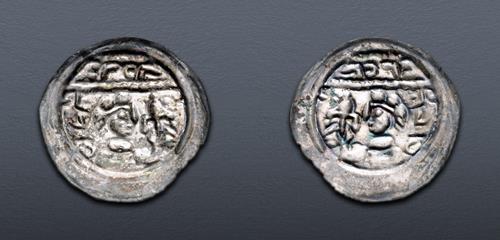|
POLAND, Monarchy. Mieszko III Stary (the Old). As Duke of Greater Poland, 1181/2-1202. AR Bracteate Denar (17mm, 0.11 g). Gniezno mint. Bust left, holding lis; above and to right, towa bracha (“Good blessing” in Hebrew) / Incuse of obverse. Gorińska type 9; Gumowski, Hebräische 234; Kopicki 115; Frynas P.9.38. Rich iridescent toning. Near EF.
From the Dr. Jay M. Galst Collection. Ex Giessener Münzhandlung 63 (21 April 1993), lot 2275.
The history of Jewish moneyers and their involvement in producing coinage in Poland is an intriguing part of history. Under Boleslaus IV (1146-1173), Jews had began to enter Poland in greater numbers as they fled from Germany where they were facing intense persecution. Some of these Jews took up positions as goldsmiths, minters, and other related positions, but under Boleslaus IV solid silver dinars continued to be minted with no Hebrew inscriptions. However, Mieszko III came up with a fiendish plan to gather the money he needed to fund further wars to acquire more territory and he intended to use the Jews to carry out his plan. Upon his succession to the throne, he instituted monetary reforms that replaced the older solid silver coins with thin low silver content bracteates and removed the old coins from circulation. Most of the new coins had a short life span, necessitating even more withdrawals and silver reductions, further enriching Mieszko III. These reforms proved extremely unpopular, but Mieszko III used the Jews as a shield as he was using them to implement his scheme, although Hebrew still was not placed on any of the coins. Eventually, he was overthrown and replaced by Casimir the Just due to his unpopularity, but Casimir was weak and the princes defied him issuing their own coins with their own Jewish mint masters. During this period, both Casimir and other princes struck bracteate with Hebrew inscriptions on them. With Poland in chaos, Mieszko III took out a large loan, which was likely funded by Jewish sources, and raised a large army and retook most of his old territory. Due to his success, he rewarded his Jewish supporters . They were given a life grant for the farming of the Gniezno mint and control of its yearly exchange. They were also appointed as tax collectors, royal monopoly keepers, and other important royal positions. All of his coins during this second period of rule also bear Hebrew inscriptions. This would continue intermittently till the reign of his great grandson Przemeslaus I. Przemeslaus I was also given a large loan by the Jews of Gniezno which he used to reconquer lost territory and so again Hebrew became a common sight to see on state coinage in Poland. The last Polish ruler to permit Hebrew on their own coins was Przemeslaus II, who was also given a large loan by the Jews of Gniezno to help him claim the throne. In this period, we actually see the head of a Jewish man placed on the coinage rather than that of a king, truly an astonishing sight. This is how during the 12th and 13th centuries the currency of Poland was issued by Jewish mint masters with Hebrew inscriptions.
The final winners of all Triton XXV lots will be determined at the live public sale that will be held on 11-12 January 2022. Triton XXV – Session Four – Early Medieval & Islamic Coinage through Large Lots will be held Wednesday afternoon, 12 January 2022 beginning at 2:00 PM ET.
Winning bids are subject to a 20% buyer's fee for bids placed on this website and 22.50% for all others.
We recognize that our users may have various Internet Browsers and Operating Systems. We like our visitors to have the best possible experience when using our bidding platform. However, we do recognize that it is impossible to develop applications that work identically, efficiently and effectively on all web browsers. The CNG bidding platform supports the latest stable major version and the stable previous version of Mozilla Firefox and Chrome.
|
